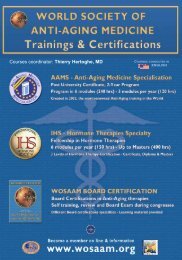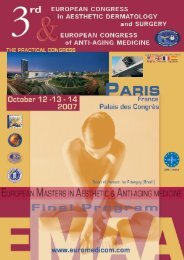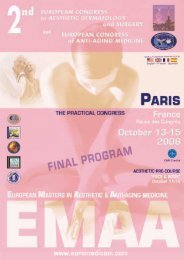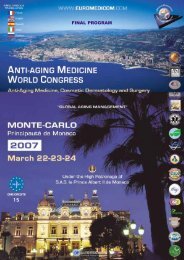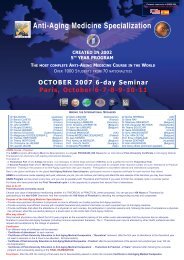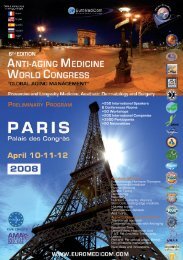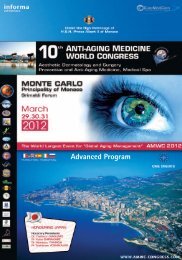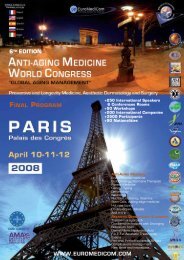FINAL PROGRAM 6TH EDITION - EuroMediCom
FINAL PROGRAM 6TH EDITION - EuroMediCom
FINAL PROGRAM 6TH EDITION - EuroMediCom
You also want an ePaper? Increase the reach of your titles
YUMPU automatically turns print PDFs into web optimized ePapers that Google loves.
The internal organs can be treated with sodium bicarbonate by locating suitable catheters in their arteries (liver, pancreas, prostate,limbs) or in the cavities (pleura, peritoneum).It is important to treat every kind of cancer with the right dosage, 500 cc 5% or 8,4% for the administrations in vein, artery and in thecavities.Every treatment has to consider that tumour colonies regress from the 3dh to the 4th day and collapse from the 4th to the 5th day, sothat a 6 day administration is enough.A complete effective cycle is made of 6 days on 6 days off treatment, repeated 4 times.The most important side effects of this care system are thirst and tiredness.In conclusion, sodium bicarbonate is really effective against the tumours and harmless as well, it should always administered to everycancer patient.MORE NATURAL APPROACHES TO CANCER TREATMENTDES APPROCHES PLUS NATURELLES DU TRAITEMENT DU CANCERSERGE JURASUNAS(PORTUGAL)SESSION 14AACONTRIBUTING LECTURES IN ANTI-AGING MEDICINECONFERENCES PARTICIPATIVES EN MEDECINE ANTI-AGECHAIR: ASCANIO POLIMENI ANTI-AGING MEDICAL DOCTOR (ROMA, ITALY)JOSÉ MARQUEZ-SERRES ANTI-AGING MEDICAL DOCTOR (SEVILLE, SPAIN)2.00 pm / 14h00CARNOSINE AND SKIN AGINGLA CARNOSINE ET LE VIEILLISEMENT DE LA PEAUDAMIANO GALIMBERTI(ITALY)Connective tissue cells, called fibroblasts, play the leading role in the ongoing regeneration of the dermis. In order to function properly,fibroblasts must strike a delicate balance between destruction of extracellular protein and synthesis of new protein. Normally fibroblastsare quiescent, dividing at a low rate. They produce only small amounts of the matrix metalloproteinase enzymes (collagenase andstromelysin) that break down the surrounding extracellular matrix, and large amounts of matrix metalloproteinase inhibitors (TIMP-1and TIMP-2). But in response to various stimuli including wounding and inflammation, they undergo a drastic transformation intoactivated fibroblasts. They then secrete large amounts of enzymes that break down collagen and destroy the extracellular matrix.Cellular senescence locks fibroblasts and keratinocytes into an approximation of this activated state (West MD, 1994). They switchfrom a matrix-producing to a matrix-degrading mode, secreting more matrix metalloproteinases and less matrix metalloproteinaseinhibitors. Senescent fibroblasts and keratinocytes are known to accumulate in aging skin, as demonstrated by a biomarker of skin cellsenescence (Dimri GP et al., 1995). In addition to breaking down the extracellular matrix, they secrete proinflammatory mediators suchas interleukin-1 alpha and growth factors such as heregulin (regulator of breast and epithelial cell growth) whose influence extends farbeyond the cell secreting them (Campisi J, 1998; Campisi J, 1997).Proteasome activity declines in keratinocytes and epidermal cells with age. At the same time, protein carbonyl levels are rising andthe increasing numbers of senescent cells are secreting more proteolytic enzymes.Carnosine has been shown to rejuvenate cells displaying the senescent phenotype, quickly restoring the juvenile phenotype(McFarland GA et al., 1999; McFarland GA et al., 1994). Elderly cells rejuvenated by carnosine lived 3 times longer than cells withoutcarnosine. When the rejuvenated cells were removed from the carnosine rich environment,they assumed appereance and behavior ofaging cells. Carnosine stimulates a factor called vimentin that promotes robustness in cultured fibroblasts (Ikeda D et al., 1999).Vimentin is a structural protein that imparts strength and stability to fibroblasts and endothelial cells. Carnosine preserves the integrityof rat fibroblasts in a nutritionally deficient culture medium (Kantha SS et al., 1996). Carnosine significantly reduced 8-hydroxydeoxyguanosine levels in fibroblasts after four weeks of continuous culture. DNA oxidation is thought to contribute importantlynot only to cellular senescence. The natural dipeptide carnosine offers a superior efficacy and toxicity profile compared toaminoguanidine (Munch G et al., 1997; Preston JE et al., 1998; Burcham PC, 2000). Carnosine rejuvenates senescent fibroblasts.Carnosine helps reverse proteasomal decline. Carnosine addresses the major pathways through which proteins become carbonylatedthrough its antioxidant and anti-glycation actions, its ability to quench reactive aldehydes and chelate metals, and its effectivenessagainst lipid peroxidation.Now that many are cutting down on meat-the main dietary source of carnosine-supplementation becomes especially important.Carnosine is safe, with no toxicity even at dosages above 500 mg per kilogram of body weight in animal studies (Quinn PJ et al., 1992).The enzyme carnosinase breaks down carnosine into aminoacides.It must be saturated with more carnosine than it is able to neutralizein order to make free carnosine available to the rest of the body. An effective dosage of carnosine is 1000mg x day (500 mgx2).ANTI-AGING MEDICINECOMPLEMENTARY ANTIOXYDANT FUNCTION OF CAFFEINE AND GREEN TEA POLYPHENOLS FOR THE SKINEFFET ANTI-OXYDANT COMPLÉMENTAIRE DE LA CAFÉINE ET DES POLYPHÉNOLS DU THÉ VERT SUR LA PEAUJARED JAGDEO(USA)The study of free radicals is particularly relevant in the context of human skin carcinogenesis and photoaging because of their abilityto induce DNA mutations and damaging lipid peroxidation byproducts, including 4-hydroxy-2-nonenal (HNE). Therefore, it is importantto identify and evaluate agents with the ability to modulate intracellular free radicals and HNE.The purpose of this research is to investigate the ability of anti-oxidants green tea polyphenols (GTPs) and caffeine, alone and incombination, to modulate the hydrogen peroxide (H2O2)-induced upregulation of reactive oxygen species (ROS) free radicals andHNE in normal human skin fibroblast WS-1 cells in vitro. GTPs and caffeine were selected for evaluation because in clinical and animal105




